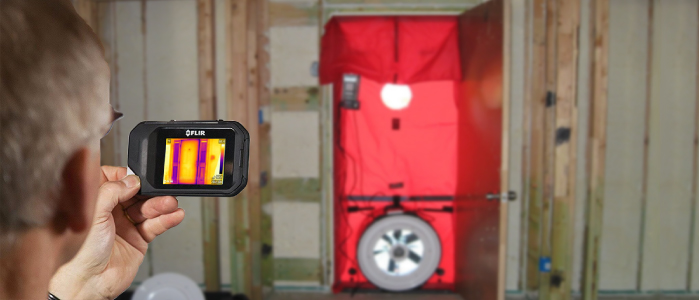Assessing air permeability is the best way of checking whether a property is airtight or not, particularly around areas other than windows and door frames. Airtightness is an important factor to consider as it gives a clear indication of material, component and workmanship standards as well as having an effect on running costs. Thermal imaging provides a great way of assessing air permeability using the blower door method and is therefore ideal for spotting defects before they start to worsen or cost money.
What is the Blower Door Method?
The blower door method works on the simple principle of osmosis. It works by temporarily installing a sealed door with an incorporated fan that will then reduce or increase the pressure in a room so that the air will look to escape to lower pressure outdoors or infiltrate the room from the outside.
An accurate manometer assesses the pressure difference between the room and the outside space during the test. Temperature differences between exterior and interior air will then allow the observer to find sources of outside air, thus locating problems with the building.
How is Thermal Imaging used with the Blower Door Method?
The advantage of using the blower door method with thermal imaging is that the user can actually see defects on screen. However, this does make it important that there is a large temperature difference of at least 5˚C between a room/property and the outdoors. This then allows the user to see cooler air infiltrating a space, so the pressure in the room or property should be at least -50 Pa compared to the air outside.
On a regular ‘hot-iron’ colour palette, cooler air will show up as a darker purple or blue colour and allows the user to pinpoint issues in insulation or draughts. Although windows and doors often lead to problems with air permeability, a particular strength of thermal imaging with the blower door method is finding weaknesses in other areas. This often includes attic utility chases, wall insulation defects, and ducts for cables, ventilation and pipes.
Which Thermal Camera is Appropriate?
As the blower door method results in colder air infiltrating the room under assessment and this air should be at least 5˚C colder than the ambient air, a relatively low-specification thermal imager will be appropriate for assessment alongside the blower door method. A model such as the FLIR C5 - with a thermal resolution of 160 x 120 pixels - would be suitable and we stock several low-cost thermal cameras with appropriate capabilities for this function. We also hold several hire models that can be viewed here and hired for as little as £95 per week.

